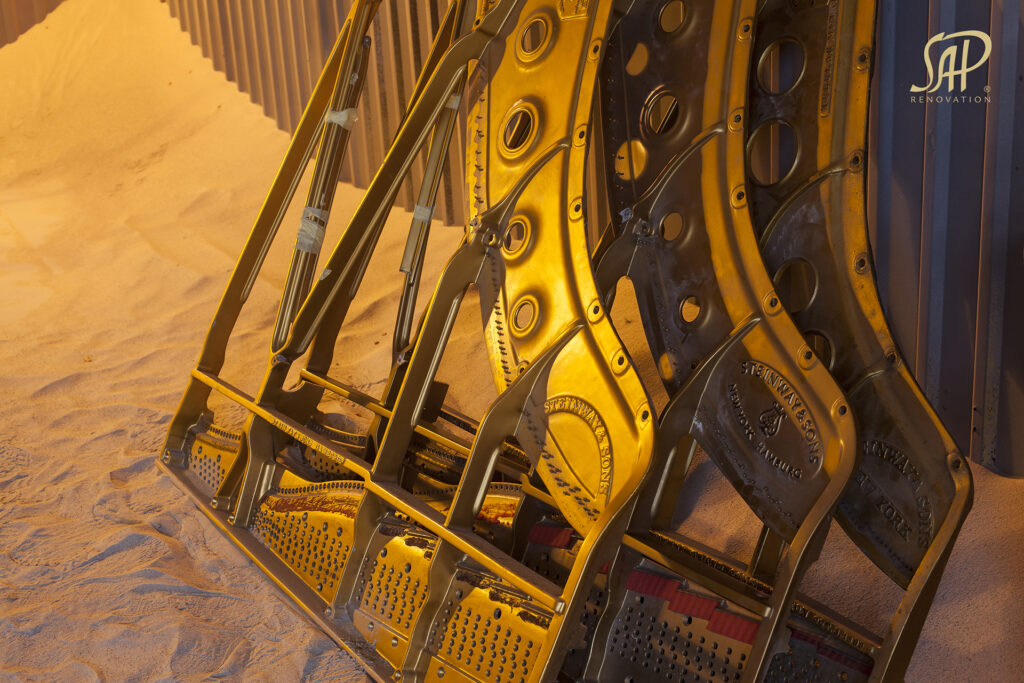
Restoration and Welding of Cast-Iron Piano Frames
The cast-iron frame is the skeleton of the piano – a structural element that bears the string tension of up to 15–18 tons.
Its technical condition is crucial for the tuning stability, safety, and tonal integrity of the instrument.
At SAP Renovation, we carry out complete restoration and repair of cast-iron frames, restoring their original strength and appearance.
1. Inspection and Diagnostics
We begin each restoration with a comprehensive structural inspection.
Our technicians examine the braces, agraffe areas, hitch-pin zones, and capo-bar section.
Typical issues include micro-cracks and delaminations around holes, which can compromise both safety and tuning stability.
2. Surface Cleaning
Old lacquer coatings are removed mechanically by sandblasting or shot-blasting with controlled granulation.
This process reveals the true condition of the iron and ensures perfect adhesion for subsequent protective layers.
3. Repairs and Regeneration
Damaged threads and holes are rebuilt using threaded inserts, system bushings, or the stitching-pins method, which restores the original load-bearing capacity and geometry of the mounting points.
As a result, the frame regains full functionality and long-term durability.
4. Finishing and Lacquering
The finishing stage is carried out in multiple layers – from an anti-corrosion primer, through piano-grade bronze or gold lacquer, to a final clear coat with controlled gloss.
Depending on preference, frames can be finished in high-gloss, semi-gloss, or matte.
Our palette includes over 50 shades and tones, allowing us to reproduce the original colors of leading manufacturers such as Steinway & Sons, Bechstein, or Blüthner.
5. Installation and Fitting
During re-assembly, we ensure uniform contact between the frame and the wooden bed, tighten bolts in a precise cross-sequence, and achieve perfect alignment with the pinblock and soundboard.
Only this level of precision guarantees even load distribution and long-term tuning stability.
6. Conservation Documentation
For historic instruments, every stage of intervention is photographically and dimensionally documented to ensure full conservation traceability and future reference.
7. Final Result
The restoration of a cast-iron frame is not only about safety and structural longevity.
A stable geometry of string positioning enhances projection, sustain, and clarity of tone, while minimizing unwanted vibrations and micro-shifts.
The final result visually and acoustically equals – or exceeds – that of a concert-grade instrument.
Welding of Cast-Iron Frames
A cracked piano frame does not mean the instrument is beyond repair.
With decades of experience, SAP Renovation undertakes repairs once thought impossible, including the welding of cast-iron piano frames under full thermal and structural control.
1. Surface Preparation
All impurities are removed from the welding area by sandblasting, preventing gas bubbles and non-metallic inclusions.
This step is essential for achieving a clean, strong, and visually flawless weld.
2. Filler Material Selection
When selecting the filler alloy, we consider:
- the type of cast iron and frame geometry,
- the mechanical and thermal properties of the filler material,
- machinability and aesthetic integration of the joint.
Each repair is preceded by a technological test and micro-structural inspection to ensure maximum durability and the best possible visual result.
Don’t Give Up on Your Piano
A cracked frame doesn’t mean the end of your instrument.
Contact SAP Renovation – we will restore its structure, safety, and beauty.
Thanks to our experience, precision, and passion, we have saved dozens of instruments that now play again in concert halls and private homes around the world.
The final effect? A perfect combination of engineering, craftsmanship, and art.


































